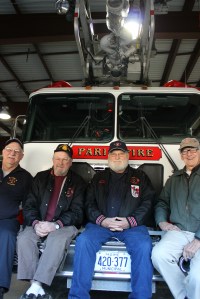PARIS — When Capt. Ben E. Conant first signed on to be a firefighter in the early 1960s, supplies were such that if he wasn’t quick enough, he’d find himself without a standard-issued raincoat and rubber boats to extinguish a blaze in his street clothes.
Which always meant he’d have to buy a new pair.
“There’s one thing you were sure of when you started in this department. If there was a structure fire, you were going to need a new set of clothes,” Conant said.
There’s over 200 years of experience fighting fires between the top four members of the Paris Fire Department, a living memory that stretches back to the lively days when firefighters swarmed out of the town’s manufacturing and textile businesses in downtown for $.50 an hour to respond to the call for help, whose experiences forged a family-like camaraderie shared to this day.
Recently, fire Chief Brad Frost honored firefighters with fifty or more years of experience for the town of Paris with a special badge. They include Deputy Chief Willie Buffington, 72, 50 years as a firefighter, Capt. Ben E. Conant, 78, with 53 years of experience, Capt. George Brown, 82, 50 years of experience.
Frost, who took coaxing to join the interview last Friday, saying, “This is about them; it’s their day,” has spent over 52 years as a firefighter.
From their earliest days, the four saw themselves as lifelong firefighters. Brown started in New Jersey; Conant joined after serving in the Navy and Buffington was talked into it by a friend after he moved from New Hampshire. Frost joined after a stint with Norway.
“We used to do all of our training basically on the job. I followed the older guys and learned from them,” Buffington said.
Cataloguing the evolution of the Fire Department is as much a lesson in how technology has changed as it is in civics, Frost said. Their history runs from a golden era when they joined and businesses could be called upon to let their workers lend a hand to fight a blaze to modern times with calls for assistance rising dramatically even as the number of firefighters moves in the opposite direction.
They’ve seen it all, from domestic trivialities to tragedies 40 years old, still spoken of in hushed tones.
“I can remember when we had to race to the fire station to get an air-pack. The first four people got one; the rest used a handkerchief,” Frost said. “When I first started, we’d do 65-70 calls a year; if we did 100, we were really busy. We had 518 calls this past year.”
“That’s the way it was,” Brown said.
Frost said the next fifty years of firefighting will take more changes still. The cost for service is rising. Neighboring communities will likely have to consolidate forces if they want to keep budgets from ballooning. At the same time, it becomes harder and harder to find people willing to do the training-intensive, dangerous work.
“Back then, it was a hobby. It’s a business now,” he said.
Second Deputy fire Chief Jon Longley, who has 32 years of experience, said one constant remains: When called, they answer.
“These guys still work harder than the younger guys. It’s amazing we still have that leadership. People want to learn from them; they’re role models,” Longley said.

Comments are no longer available on this story